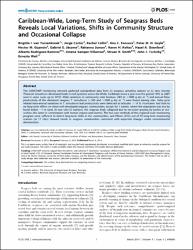Mostrar el registro sencillo del ítem
Caribbean-wide, long-term study of seagrass beds reveals local variations, shifts in community structure and occasional collapse
| Licencia | This is an open-access article, free of all copyright, and may be freely reproduced, distributed, transmitted, modified, built upon, or otherwise used by anyone for any lawful purpose. The work is made available under the Creative Commons CC0 public domain dedication | es |
| Autor | Tussenbroek, Brigitta I. van | |
| Autor | Cortés, Jorge | |
| Autor | Collin, Rachel | |
| Autor | Fonseca, Ana C. | |
| Autor | Gayle, Peter M. H. | |
| Autor | Guzmán, Héctor M. | |
| Autor | Jácome, Gabriel E. | |
| Autor | Juman, Rahanna | |
| Autor | Koltes, Karen H. | |
| Autor | Oxenford, Hazel A. | |
| Autor | Rodríguez-Ramírez, Alberto | |
| Autor | Samper-Villarreal, Jimena | |
| Autor | Smith, Struan R. | |
| Autor | Tschirky, John J. | |
| Autor | Weil, Ernesto | |
| Fecha de admisión | 2024-02-13T22:58:22Z | |
| Fecha disponible | 2024-02-13T22:58:22Z | |
| Año | 2014 | |
| Citación | van Tussenbroek, B. I., Cortés, J., Collin, R., Fonseca, A. C., Gayle, P. M., Guzmán, H. M., ... & Weil, E. (2014). Caribbean-wide, long-term study of seagrass beds reveals local variations, shifts in community structure and occasional collapse. PloS one, 9(3), e90600. Recuperado de: | es |
| URI | https://bvearmb.do/handle/123456789/4081 | |
| Sinopsis | The CARICOMP monitoring network gathered standardized data from 52 seagrass sampling stations at 22 sites (mostly Thalassia testudinum-dominated beds in reef systems) across the Wider Caribbean twice a year over the period 1993 to 2007 (and in some cases up to 2012). Wide variations in community total biomass (285 to >2000 g dry m−2) and annual foliar productivity of the dominant seagrass T. testudinum (<200 and >2000 g dry m−2) were found among sites. Solar-cycle related intra-annual variations in T. testudinum leaf productivity were detected at latitudes > 16°N. Hurricanes had little to no long-term effects on these well-developed seagrass communities, except for 1 station, where the vegetation was lost by burial below ∼1 m sand. At two sites (5 stations), the seagrass beds collapsed due to excessive grazing by turtles or sea-urchins (the latter in combination with human impact and storms). The low-cost methods of this regional-scale monitoring program were sufficient to detect long-term shifts in the communities, and fifteen (43%) out of 35 long-term monitoring stations (at 17 sites) showed trends in seagrass communities consistent with expected changes under environmental deterioration. | es |
| Idioma | English | es |
| Publicado | PloS one, 9(3), e90600 | es |
| URI de derechos | https://creativecommons.org/public-domain/cc0/ | es |
| Materia | Biodiversidad | es |
| Materia | Recursos costeros y marinos | es |
| Materia | Arrecifes de coral | es |
| Título | Caribbean-wide, long-term study of seagrass beds reveals local variations, shifts in community structure and occasional collapse | es |
| dc.identifier.doi | https://doi.org/10.1371/journal.pone.0090600 | |
| Tipo de material | Article | es |
| Tipo de contenido | Scientific research | es |
| Acceso | Open | es |
| Audiencia | Technicians, professionals and scientists | es |
Ficheros en el ítem
Este ítem aparece en la(s) siguiente(s) colección(es)
-
Investigación ambiental [1725]
La consulta y descarga de este documento están sujetas a esta licencia: This is an open-access article, free of all copyright, and may be freely reproduced, distributed, transmitted, modified, built upon, or otherwise used by anyone for any lawful purpose. The work is made available under the Creative Commons CC0 public domain dedication



